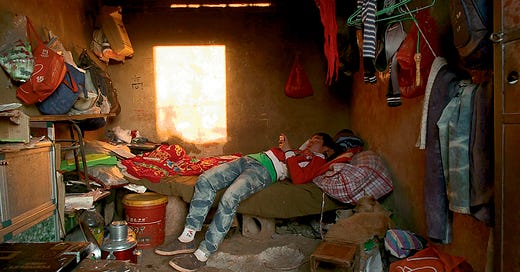THERE IS A BLUNTNESS, even a brutality, to Wang Bing’s documentary films, which typically plod at an agonizing pace—’Til Madness Do Us Part (2013), filmed inside a men’s mental hospital, lasts three hours and forty-seven minutes; Tie Xi Qu: West of the Tracks, his 2002 debut, examines a declining industrial area for just over nine hours; Crude Oil (2008) devotes fourteen hours to the daily activities of oil field workers. Unlike typical exercises in “slow cinema,” as minimalist long-take auteur filmmaking has come to be called, Wang’s films produce a brutal effect that lies not merely in their length or their unpleasant subject matter but also in the way they are made.
In recent years, there has been a shift away from the lo-fi aesthetic that enjoyed vanguard status at the end of the last century, from the advent of punk through the 1990s. This change is due in large part to a flourishing of affordable, easy-to-use technology. Wang’s films tend to be shot on cheap, handheld digital devices, the director often working with a crew of zero. There is a deliberate, even disturbing artlessness to these works. In Tie Xi Qu, dirt, grime, and water stains can frequently be discerned on the lens—an appropriate sullying, given that the entire film takes place in the heavy industrial zone of the city of Shenyang in northeast China, but a shock in the era of Photoshop perfection.
The three-hour Fengming: A Chinese Memoir (2007) is a sustained reminiscence by an elderly woman, a once-staunch Communist who lived through the entirety of Mao’s reign, from the Liberation in 1949 to the Anti-Rightist Campaign of the 1950s to the Cultural Revolution of 1966–76, and was purged and rehabilitated repeatedly. The film was shot mostly in her living room with a single camera on a tripod, in extremely long takes; when the interviewee gets up for a bathroom break, Wang leaves the camera running, we hear the toilet flush in the next room, and she returns to the couch and resumes her monologue. The only interjection Wang himself makes is to ask her, once the sun goes down, to turn on a lamp.
The bulk of Father and Sons (2014)—a film about a Chinese migrant worker family—is similarly static. Running a mere hour and a half, it focuses on a teenage boy sprawled on the bed he shares with his brother and father in their one-room, dirt-floor hut, his attention wavering back and forth from the glare of the off-screen television set to the screen of his mobile phone.
But Wang’s filmmaking isn’t all fixed camerawork and long-duration shots. In fact, it’s often animated by a wandering agency. Although the camera never quite becomes a character per se, the filmmaker’s consciousness is constantly referenced by the camera’s movements. In ’Til Madness Do Us Part, one of the subjects in the mental institution darts out of the frame and begins running through the hallways; the camera hesitates for a few seconds, then suddenly begins chasing behind him. Tie Xi Qu boasts a similar scene in the factory’s break room, where a worker strips naked while giving one of the film’s countless tirades on financial duress. He then brusquely walks out. The camera lingers briefly, then rushes to the door, pursuing him down the hallway and into the shower room. These moments of hesitation, instead of being edited out of the film, as would be done in a conventional documentary to create a more polished product, become vehicular forces of momentum, reasserting cinema’s affirmative presence as an art that is human, all-too-human.
Wang teaches a lesson that is apparently not taught in film schools any longer: when your material is good enough, you don’t need very much in the way of technology to make a moving, potent film. He also exhibits starkly naturalistic but knowingly composed photographs related to his projects—images no less empathetic for their formal refinement. The richness of Wang’s works lies not in their budget but in their human resources—namely, his subjects, who more often than not are very poor. Wang’s primary concern is with the losers of global capitalism. Without attempting to manipulate the viewer emotionally, using only the sparsest narrative machinery (occasional textual interjections supplying pertinent background information), Wang sheds a dignified light on people who otherwise have no great social standing or expectations.
Keep reading with a 7-day free trial
Subscribe to Travis Jeppesen to keep reading this post and get 7 days of free access to the full post archives.



